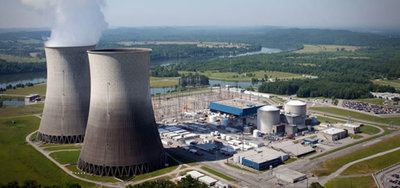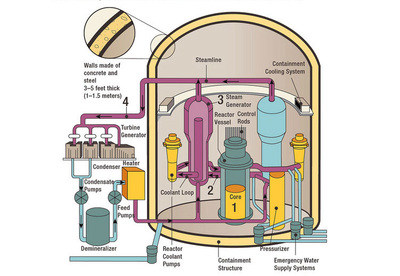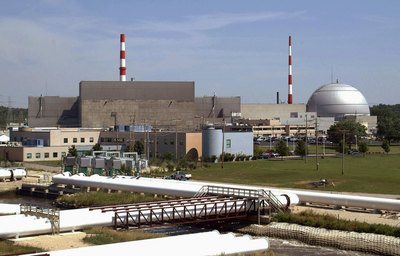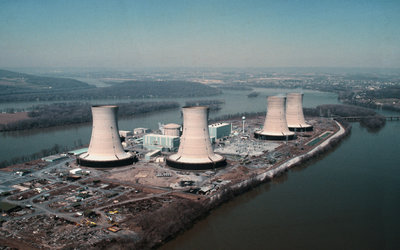Nuclear Fission
Current Status

(click image to enlarge)
Construction of nuclear power plants in the United States has been almost totally dormant for many years. After a flurry of building in the 1960's and 70's, interest in new nuclear power plants reached a peak then declined through the 80's. Ultimately, construction of nuclear power reactors dropped steeply, even as numerous existing plants, due to age, were taken out of service. Four reactors were permanently shut down in 2013, and one reactor was taken out of service in 2014. The newest reactor to enter service, Watts Bar Unit 2, came online in 2016.
Nuclear Plants

(click image to enlarge)
There are presently 99 nuclear power plants licensed to operate in the United States. They are exclusively of two types, boiling-water nuclear reactors (BWR) and pressurized-water nuclear reactors (PWR). Of those 99, 65 are PWR's and 34 are BWR's. Together, they generate approximately 20% of the electricity used in the U.S.
Nuclear Fuel
Most nuclear power reactors use Uranium-235 or plutonium-239 as its fuel for generating electricity. When the atomic nuclei of these fuels are struck by neutrons, they can split into smaller nuclei, releasing sizable amounts of energy in the process. Another very important product of this splitting process is the simultaneous release of two or more other neutrons, which can go on to split more fuel nuclei. This becomes a self-perpetuating "chain reaction". This chain reaction perpetuates the desired energy release, and, when properly moderated and controlled, the process can proceed virtually indefinitely, until the original fuel is consumed and diluted to the point where the chain reaction is no longer self-sustaining.
Nuclear Waste
The disposal of nuclear waste is both an engineering and a political challenge. As far as the engineering side of that challenge is concerned, it basically boils down to developing ways to safely contain dangerous radioactive substances for several centuries, while the material decays to a harmless level of radiation. That seems like a long time, but most solutions accepted as effective by professionals in the field involve deep geological burial, and in geologic terms, a few centuries are like the blink of an eye. Finding stable geological formations for burial of radiological waste lends itself to straightforward analysis and should be a readily solved problem. However, the solution to this problem has been fraught in the USA with both engineering difficulties and resistance from local residents that have delayed the development of a permanent, deep geological repository.
The more difficult problem in the disposal of radioactive waste is the political challenge. Much resistance arises from local populations when an area is selected or undergoes examination for a repository site. Legitimate challenges to the engineering solution get mixed in with apprehension over having harmful radiological substances stored nearby and cause long delays in developing a safe repository for the material.
Environment
Environmental issues relating to nuclear power fall into three categories:
- Disposal of nuclear waste.
- Contamination due to accidents
- CO2 release into the atmosphere due to use of fossil fuels during mining of fuel ore and construction of nuclear plants
Economics

(click image to enlarge)
When Unit 2 of the Dresden Nuclear Power Plant was activated in 1970, it had cost the owning utility, Commonwealth Edison, a modest sum, compared with what was soon to come. Fourteen years later plants had construction costs over 10 times as much and took many years longer to build. The burden of construction became the overriding concern for utilities in considering the option of using nuclear energy to generate electricity. This type of costly experience (plus the accidents at Three Mile Island and Chernobyl) effectively ended nuclear power plant construction for many years in the USA.
Safety

(click image to enlarge)
On March 28, 1979 a sequence of events took place at the TMI-2 reactor at the Three Mile Island Nuclear Power Plant near Middletown, PA that resulted in the most serious accident in U.S. commercial nuclear power plant operating history. It was later determined that, due to design deficiencies, mechanical malfunction and human error, the reactor overheated and about half of the reactor core melted. Very small amounts of radiation leaked from the reactor into the surrounding areas.
The event transformed the nuclear industry and the governmental policies regulating the industry's safety standards. Sweeping changes at the Nuclear Regulatory Commission (NRC) and its policies greatly altered the safety requirements for all nuclear power plants and the design criteria that were expected for new construction.
Accidents
There have been several accidents at nuclear power plants around the world, since nuclear power was first harnessed for peaceful uses. Of those accidents, the three most damaging and most well-known are (1) Three Mile Island, (2) Chernobyl, and (3) Fukushima-Daiichi.
Security
The Nuclear Regulatory Commission is charged with formulating and enforcing standards of safety and security at U.S. nuclear power plants. The guiding criteria for the NRC in this capacity is the Energy Policy Act of 2005, which addressed several issues in light of the 9/11 attacks on the World Trade Center.
As a result of several years of study and improvement of conditions by the NRC, nuclear power plants in the USA are now much more heavily and effectively guarded against adversaries, whether their action takes the form of sabotage, theft, cybercrime or direct, violent attack.
Nuclear Industry
The nuclear industry consists of multiple types of entities, from government to commercial to scientific. Following are the principle components of the industry:
- Uranium Mining and Enrichment
- Builders and operators of nuclear power plants
- Disposal of nuclear waste
- National and International Organizations
- Regulators
- Research and Development